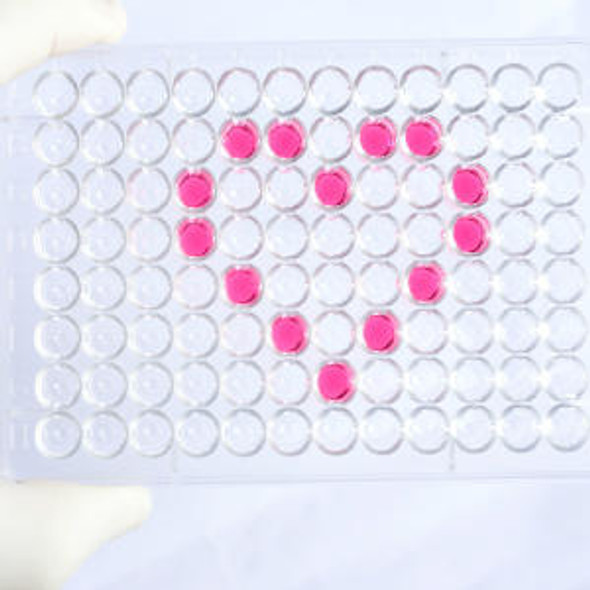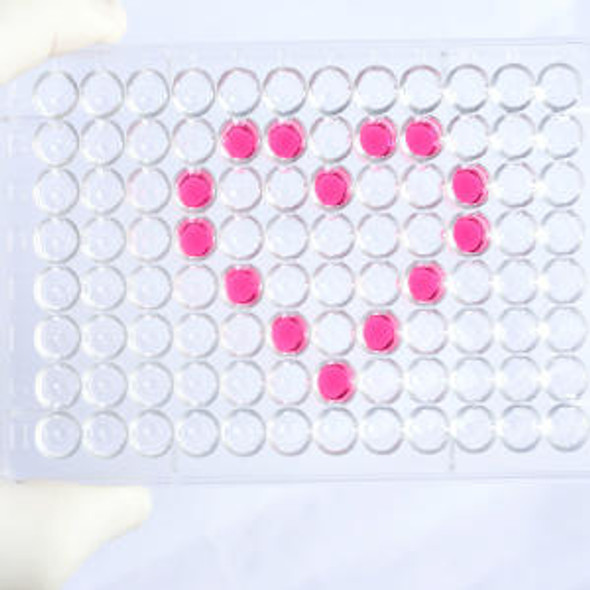Human CDK6 (Cyclin Dependent Kinase 6) ELISA Kit (HUES01538)
- SKU:
- HUES01538
- Product Type:
- ELISA Kit
- Size:
- 96 Assays
- Uniprot:
- Q00534
- Sensitivity:
- 0.09ng/mL
- Range:
- 0.16-10ng/mL
- ELISA Type:
- Sandwich
- Synonyms:
- PLSTIRE, Cell division protein kinase 6
- Reactivity:
- Human
- Sample Type:
- Serum, plasma and other biological fluids
- Research Area:
- Cell Cycle
Description
Human CDK6 (Cyclin Dependent Kinase 6) ELISA Kit
The Human CDK6 (Cyclin-Dependent Kinase 6) ELISA Kit is specifically designed for the precise measurement of CDK6 levels in human serum, plasma, and cell culture supernatants. This kit offers exceptional sensitivity and specificity, ensuring accurate and consistent results for various research applications.CDK6 is a key enzyme involved in cell cycle regulation, playing a crucial role in cell growth and division. Dysregulation of CDK6 is associated with various diseases, including cancer and neurological disorders, making it a valuable biomarker for studying these conditions and developing targeted therapies.
With its high-quality components and user-friendly protocols, the Human CDK6 ELISA Kit from Assay Genie is an essential tool for researchers looking to investigate the role of CDK6 in disease pathogenesis and explore potential treatment options.
| Assay type: | Sandwich |
| Format: | 96T |
| Assay time: | 4.5h |
| Reactivity: | Human |
| Detection Method: | Colormetric |
| Detection Range: | 0.16-10 ng/mL |
| Sensitivity: | 0.10 ng/mL |
| Sample Volume Required Per Well: | 100µL |
| Sample Type: | Serum, plasma and other biological fluids |
| Specificity: | This kit recognizes Human CDK6 in samples. No significant cross-reactivity or interference between Human CDK6 and analogues was observed. |
This ELISA kit uses Sandwich-ELISA as the method. The micro ELISA plate provided in this kit has been pre-coated with an antibody specific to Human CDK6. Standards or samples are added to the appropriate micro ELISA plate wells and combined with the specific antibody. Then a biotinylated detection antibody specific for Human CDK6 and Avidin-Horseradish Peroxidase (HRP) conjugate are added to each micro plate well successively and incubated. Free components are washed away. The substrate solution is added to each well. Only those wells that contain Human CDK6, biotinylated detection antibody and Avidin-HRP conjugate will appear blue in color. The enzyme-substrate reaction is terminated by adding Stop Solution and the color turns yellow. The optical density (OD) is measured spectrophotometrically at a wavelength of 450 nm ± 2 nm. The OD value is proportional to the concentration of Human CDK6. The concentration of Human CDK6 in samples can be calculated by comparing the OD of the samples to the standard curve.
| UniProt Protein Function: | CDK6: a protein kinase of the CDK family. Important for cell cycle G1 phase progression and G1/S transition. The activity of this kinase first appears in mid-G1 phase, controlled by the regulatory subunits including D-type cyclins and members of INK4 family of CDK inhibitors. Phosphorylates and regulates the activity of the Rb tumor suppressor protein. Overexpressed and/or disrupted by translocation in leukemias, lymphomas and other cancers and amplified in gliomas and rodent cancers. |
| UniProt Protein Details: | Protein type:Protein kinase, Ser/Thr (non-receptor); Kinase, protein; EC 2. 7. 11. 22; Protein kinase, CMGC; Cell cycle regulation; CMGC group; CDK family; CDK/CDK4 subfamily; CDK4 subfamily Chromosomal Location of Human Ortholog: 7q21-q22 Cellular Component: centrosome; cyclin-dependent protein kinase holoenzyme complex; cytoplasm; cytosol; nucleoplasm; nucleus; ruffle Molecular Function:ATP binding; cyclin binding; cyclin-dependent protein kinase activity; protein binding Biological Process: astrocyte development; cell cycle arrest; cell dedifferentiation; dentate gyrus development; G1/S transition of mitotic cell cycle; generation of neurons; gliogenesis; lateral ventricle development; negative regulation of cell cycle; negative regulation of cell differentiation; negative regulation of cell proliferation; negative regulation of epithelial cell proliferation; negative regulation of myeloid cell differentiation; negative regulation of osteoblast differentiation; positive regulation of cell-matrix adhesion; positive regulation of fibroblast proliferation; protein amino acid phosphorylation; regulation of erythrocyte differentiation; regulation of gene expression; response to virus Disease: Microcephaly 12, Primary, Autosomal Recessive |
| NCBI Summary: | The protein encoded by this gene is a member of the cyclin-dependent protein kinase (CDK) family. CDK family members are highly similar to the gene products of Saccharomyces cerevisiae cdc28, and Schizosaccharomyces pombe cdc2, and are known to be important regulators of cell cycle progression. This kinase is a catalytic subunit of the protein kinase complex that is important for cell cycle G1 phase progression and G1/S transition. The activity of this kinase first appears in mid-G1 phase, which is controlled by the regulatory subunits including D-type cyclins and members of INK4 family of CDK inhibitors. This kinase, as well as CDK4, has been shown to phosphorylate, and thus regulate the activity of, tumor suppressor protein Rb. Expression of this gene is up-regulated in some types of cancer. Multiple alternatively spliced variants, encoding the same protein, have been identified. [provided by RefSeq, Nov 2009] |
| UniProt Code: | Q00534 |
| NCBI GenInfo Identifier: | 223718134 |
| NCBI Gene ID: | 1021 |
| NCBI Accession: | NP_001138778. 1 |
| UniProt Secondary Accession: | Q00534,A4D1G0, |
| UniProt Related Accession: | Q00534 |
| Molecular Weight: | 36,938 Da |
| NCBI Full Name: | cyclin-dependent kinase 6 |
| NCBI Synonym Full Names: | cyclin dependent kinase 6 |
| NCBI Official Symbol: | CDK6 |
| NCBI Official Synonym Symbols: | MCPH12; PLSTIRE |
| NCBI Protein Information: | cyclin-dependent kinase 6 |
| UniProt Protein Name: | Cyclin-dependent kinase 6 |
| UniProt Synonym Protein Names: | Cell division protein kinase 6; Serine/threonine-protein kinase PLSTIRE |
| Protein Family: | Cyclin-dependent kinase |
| UniProt Gene Name: | CDK6 |
| UniProt Entry Name: | CDK6_HUMAN |
As the OD values of the standard curve may vary according to the conditions of the actual assay performance (e. g. operator, pipetting technique, washing technique or temperature effects), the operator should establish a standard curve for each test. Typical standard curve and data is provided below for reference only.
| Concentration (ng/mL) | O.D | Average | Corrected |
| 10 | 2.417 2.449 | 2.433 | 2.377 |
| 5 | 1.646 1.662 | 1.654 | 1.598 |
| 2.5 | 0.923 0.887 | 0.905 | 0.849 |
| 1.25 | 0.41 0.428 | 0.419 | 0.363 |
| 0.63 | 0.265 0.255 | 0.26 | 0.204 |
| 0.32 | 0.172 0.144 | 0.158 | 0.102 |
| 0.16 | 0.104 0.112 | 0.108 | 0.052 |
| 0 | 0.051 0.061 | 0.056 | -- |
Precision
Intra-assay Precision (Precision within an assay): 3 samples with low, mid range and high level Human CDK6 were tested 20 times on one plate, respectively.
Inter-assay Precision (Precision between assays): 3 samples with low, mid range and high level Human CDK6 were tested on 3 different plates, 20 replicates in each plate.
| Intra-assay Precision | Inter-assay Precision | |||||
| Sample | 1 | 2 | 3 | 1 | 2 | 3 |
| n | 20 | 20 | 20 | 20 | 20 | 20 |
| Mean (ng/mL) | 0.48 | 0.85 | 4.77 | 0.46 | 0.80 | 4.57 |
| Standard deviation | 0.03 | 0.04 | 0.22 | 0.02 | 0.05 | 0.14 |
| C V (%) | 6.25 | 4.71 | 4.61 | 4.35 | 6.25 | 3.06 |
Recovery
The recovery of Human CDK6 spiked at three different levels in samples throughout the range of the assay was evaluated in various matrices.
| Sample Type | Range (%) | Average Recovery (%) |
| Serum (n=5) | 86-101 | 93 |
| EDTA plasma (n=5) | 85-98 | 91 |
| Cell culture media (n=5) | 90-103 | 97 |
Linearity
Samples were spiked with high concentrations of Human CDK6 and diluted with Reference Standard & Sample Diluent to produce samples with values within the range of the assay.
| Serum (n=5) | EDTA plasma (n=5) | Cell culture media (n=5) | ||
| 1:2 | Range (%) | 97-111 | 91-106 | 97-109 |
| Average (%) | 105 | 97 | 103 | |
| 1:4 | Range (%) | 92-105 | 83-96 | 89-102 |
| Average (%) | 98 | 90 | 95 | |
| 1:8 | Range (%) | 93-108 | 79-93 | 87-101 |
| Average (%) | 99 | 86 | 94 | |
| 1:16 | Range (%) | 88-103 | 79-94 | 86-100 |
| Average (%) | 95 | 86 | 93 |
An unopened kit can be stored at 4°C for 1 month. If the kit is not used within 1 month, store the items separately according to the following conditions once the kit is received.
| Item | Specifications | Storage |
| Micro ELISA Plate(Dismountable) | 8 wells ×12 strips | -20°C, 6 months |
| Reference Standard | 2 vials | |
| Concentrated Biotinylated Detection Ab (100×) | 1 vial, 120 µL | |
| Concentrated HRP Conjugate (100×) | 1 vial, 120 µL | -20°C(shading light), 6 months |
| Reference Standard & Sample Diluent | 1 vial, 20 mL | 4°C, 6 months |
| Biotinylated Detection Ab Diluent | 1 vial, 14 mL | |
| HRP Conjugate Diluent | 1 vial, 14 mL | |
| Concentrated Wash Buffer (25×) | 1 vial, 30 mL | |
| Substrate Reagent | 1 vial, 10 mL | 4°C(shading light) |
| Stop Solution | 1 vial, 10 mL | 4°C |
| Plate Sealer | 5 pieces | |
| Product Description | 1 copy | |
| Certificate of Analysis | 1 copy |
- Set standard, test sample and control (zero) wells on the pre-coated plate and record theirpositions. It is recommended to measure each standard and sample in duplicate. Note: addall solutions to the bottom of the plate wells while avoiding contact with the well walls. Ensuresolutions do not foam when adding to the wells.
- Aliquot 100 µL of standard solutions into the standard wells.
- Add 100 µL of Sample / Standard dilution buffer into the control (zero) well.
- Add 100 µL of properly diluted sample (serum, plasma, tissue homogenates and otherbiological fluids) into test sample wells.
- Cover the plate with the sealer provided in the kit and incubate for 90 min at 37 °C.
- Aspirate the liquid from each well, do not wash. Immediately add 100 µL of BiotinylatedDetection Ab working solution to each well. Cover the plate with a plate seal and gently mix. Incubate for 1 hour at 37 °C.
- Aspirate or decant the solution from the plate and add 350 µL of wash buffer to each welland incubate for 1-2 minutes at room temperature. Aspirate the solution from each well andclap the plate on absorbent filter paper to dry. Repeat this process 3 times. Note: a microplatewasher can be used in this step and other wash steps.
- Add 100 µL of HRP Conjugate working solution to each well. Cover with a plate seal andincubate for 30 min at 37 °C.
- Aspirate or decant the solution from each well. Repeat the wash process for five times asconducted in step 7.
- Add 90 µL of Substrate Reagent to each well. Cover with a new plate seal and incubate forapproximately 15 min at 37 °C. Protect the plate from light. Note: the reaction time can beshortened or extended according to the actual color change, but not by more than 30min.
- Add 50 µL of Stop Solution to each well. Note: Adding the stop solution should be done inthe same order as the substrate solution.
- Determine the optical density (OD value) of each well immediately with a microplate readerset at 450 nm.






